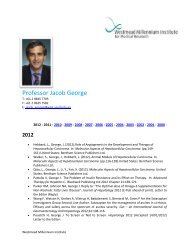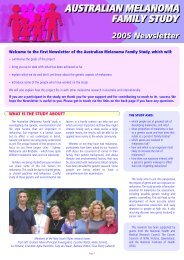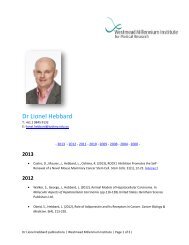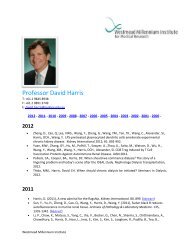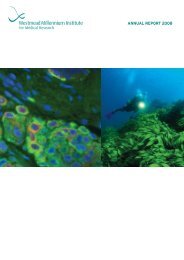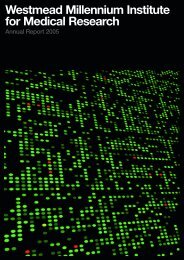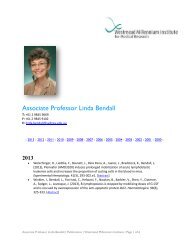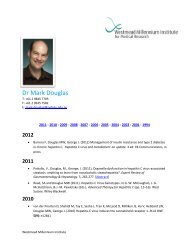Translating >> - Westmead Millennium Institute
Translating >> - Westmead Millennium Institute
Translating >> - Westmead Millennium Institute
- No tags were found...
You also want an ePaper? Increase the reach of your titles
YUMPU automatically turns print PDFs into web optimized ePapers that Google loves.
42 43 > Research Report // AR 2006<br />
doses for patients. This is an important issue since the rate at<br />
which drugs are cleared from the body can vary substantially<br />
between individuals and have a major influence on the<br />
effectiveness and toxicity of treatment.<br />
In a collaborative project with the Family Cancer group and<br />
the Kathleen Cuningham Consortium for Research into<br />
Familial Breast Cancer (kConFab), Translational Oncology<br />
also reported a study in 2006 that described the pathology<br />
features of breast cancer in carriers of variants in a gene that<br />
has been implicated in increased breast cancer risk; ataxia<br />
telangiectasia mutated (ATM). This was of interest because<br />
certain types of familial breast cancer are associated with<br />
particular pathologic features although these were not seen in<br />
carriers of ATM variants.<br />
Another major project that Translational Oncology is<br />
involved with is establishment of a Breast Cancer Tissue<br />
Bank in centres across New South Wales that will make<br />
breast cancer tissue specimens available for research Australiawide.<br />
Supported by funding from the National Health<br />
and Medical Research Council, National Breast Cancer<br />
Foundation and Cancer <strong>Institute</strong> NSW this initiative will<br />
form important infrastructure for future translational breast<br />
cancer research.<br />
Genomics and genetic epidemiology<br />
The Genomics and Genetic Epidemiology Group focuses<br />
on identifying the genes that strongly affect cancer risk<br />
and discovering how that genetic risk interacts with the<br />
environment to cause cancer. Hundreds of families of people<br />
with a strong family history of melanoma have supported the<br />
groups projects over the last twenty years and their samples<br />
continue to be used intensively to identify new melanoma<br />
genes. Over 2006 they were used in three searches involving<br />
22 research groups of the international melanoma genetics<br />
consortium (GenoMEL) and several million dollars’ funding<br />
from the European Union and the US National <strong>Institute</strong>s of<br />
Health. They cover each of the main high-throughput ways<br />
of identifying new disease genes: genetic linkage, genetic<br />
association and candidate gene analysis.<br />
The group also completed the Australian Melanoma Family<br />
Study (AMFS), with the University of Melbourne’s MEGA<br />
Centre and the Queensland Cancer Fund Epidemiology<br />
Research Unit. This is one of the world’s largest populationbased<br />
studies of melanoma, enrolling over 1100 people who<br />
developed melanoma before age 40 in Melbourne, Sydney<br />
and Brisbane, or unaffected controls, plus thousands of their<br />
family members. Early-onset melanoma can be indicative of<br />
increased susceptibility, but little is known about what genes<br />
contribute to risk in this setting. The AMFS has shown that<br />
HO<br />
3<br />
A<br />
5<br />
B<br />
6<br />
C<br />
in at least some cases (2%) a gene that is commonly mutated<br />
in familial melanoma is responsible: the CDKN2A (p16)<br />
tumour suppressor gene. The group has also showed that<br />
the risk caused by these mutated genes in the population is<br />
not as high as it is in people with a strong family history of<br />
melanoma.<br />
As part of her successful PhD Nadine Kasparian reported<br />
some of the first research anywhere in the world that has<br />
Cholestorol<br />
studied perception of melanoma risk and the psychological<br />
consequences of high melanoma risk in melanoma families.<br />
These are collaborations with Prince of Wales Hospital and<br />
the University of Sydney.<br />
Both the NHMRC and Cancer <strong>Institute</strong> NSW Program<br />
Grants have enabled the group to start wide-ranging studies<br />
with collaborators at the Sydney Melanoma Unit, directed<br />
at understanding the genetic abnormalities in melanomas<br />
themselves. The goals of these high-throughput studies<br />
of gene and protein expression are to understand how<br />
apparently similar melanomas can have such different clinical<br />
behaviour, whether a greater propensity to relapse after<br />
surgery, or differing responsiveness to drug and biological<br />
treatment, for example. Since the SMU is the largest<br />
melanoma treatment and clinical research centre in the<br />
world, these are intended to be benchmark studies of these<br />
issues and will be the main focus of the group in 2007-8.<br />
HO<br />
H<br />
17<br />
D<br />
OH<br />
OH<br />
Liver and Metabolic<br />
Storr Liver Unit<br />
The role of leptin in the pathogenesis of hepatic fibrosis<br />
The mechanisms by which the hormone leptin, which<br />
Propionyl-CoA<br />
NADP + H +<br />
circulates in increased concentrations in obese individuals,<br />
exerts its pro-fibrogenic (scarring) effects on the liver are<br />
O 2<br />
NADPH + H +<br />
currently unclear. In this project we examined the expression<br />
of pro-fibrogenic genes and proteins in cultured rat hepatic<br />
7`-hydroxylase<br />
stellate cells (HSCs; the main cellular source of scar tissue<br />
in the liver) following exposure to leptin. We were able<br />
to demonstrate that leptin did not directly enhance HSC<br />
activation. In contrast, there were remarkable increases in<br />
pro-fibrogenic gene and protein expression in HSCs after<br />
these cells were cultured in the medium of Kupffer cells that<br />
had been previously exposed to leptin. Furthermore, we<br />
found that the effect of leptin on Kupffer cells was mediated<br />
by increasing the production of connective tissue growth<br />
O<br />
factor (CTGF) and transforming growth factor beta. 2 Both<br />
C – S – CoA<br />
O<br />
2 CoA-SH<br />
these cytokines are potent stimulators of fibrosis in hepatic<br />
stellate cells. We have taken these data further and have now<br />
characterized the intracellular molecular basis by which leptin<br />
exerts its affects. This project has demonstrated that Kupffer<br />
cells play an important role in leptin-mediated liver fibrosis<br />
and provide a novel molecular mechanism by which obesity<br />
causes scarring of the liver and cirrhosis.<br />
Molecular mechanisms for the development of fatty liver<br />
disease in humans<br />
Non-alcoholic fatty liver disease (NAFLD) is the commonest<br />
cause of progressive liver damage in Australia leading to<br />
cirrhosis and liver cancer in some individuals. To date,<br />
altered lipid (fat) homeostasis has been shown to contribute<br />
to the accumulation of liver fat, but the mechanisms by<br />
which a fatty liver is converted to one with liver damage<br />
(steatohepatitis) has not been fully elucidated. In this project,<br />
researchers from the Storr Liver Unit sought to identify<br />
the molecular determinants leading to the progression to<br />
steatohepatitis. We therefore examined the expression of<br />
a number of critical nuclear receptors (NXRs) and key<br />
genes regulating carbohydrate, cholesterol and bile acid<br />
metabolism, synthesis and transport within the liver. In<br />
addition, we examined the expression of key inflammatory<br />
cytokines and pro- and anti-apoptotic cell death genes.<br />
This study was unique in that it was conducted on minute<br />
quantities of human liver tissue removed at the time of liver<br />
biopsy. Our results indicated that several nuclear receptors<br />
NADP +<br />
(LXR, PXR, FXR and CAR) which regulate key genes for<br />
bile acid synthesis and export were up-regulated in patients<br />
with steatohepatitis compared with healthy controls.<br />
Likewise, the expression of key cell death genes (BAD, BID,<br />
BAX) and those which mediate liver inflammation, were<br />
increased in livers from patients with steatohepatitis. These<br />
data are consistent with our novel proposal that alterations<br />
in nuclear receptor expression are a critical mediator of liver<br />
HO<br />
damage in patients with non-alcoholic steatohepatitis.<br />
The role of bile acids as a mediator of liver injury in an<br />
animal model of fatty liver disease<br />
In this study, we attempted to further characterise the<br />
several steps<br />
OH<br />
7-Hydroxychole<br />
molecular and cellular basis for the development of nonalcoholic<br />
steatohepatitis (NASH) by studies using an animal<br />
model that was developed at the Storr Liver Unit. NASH<br />
is characterized by the presence of hepatic steatosis (fat),<br />
liver injury, inflammation and variable fibrosis (scarring).<br />
The mechanisms which initiate hepatitis in a fatty liver<br />
are important, and at present unknown. In this research,<br />
analogous to our human studies, we sought to examine the<br />
role of nuclear receptors and key genes regulating bile acid and<br />
cholesterol metabolism, synthesis and transport within the<br />
liver of animals with NASH. Our results demonstrated that<br />
bile acids were significantly increased early in the development<br />
of NASH in mice. By day 5, we noted major changes in<br />
nuclear receptors and their downstream targets and of genes<br />
which regulate bile acid synthesis and export. Taken together<br />
these data strongly suggest that nuclear receptors and their<br />
ligands (bile acids and oxysterols) may be important mediators<br />
of liver injury in our nutritional model of NASH. It is hoped<br />
that linking these molecular studies in animals with a fatty<br />
liver, to that in humans with NASH will permit a better<br />
understanding of NAFLD and suggest novel treatments.<br />
NADP<br />
O<br />
2 CoA<br />
Prop<br />
Cholyl-CoA



